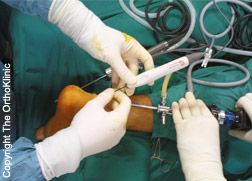|
In Greek mythology, the heels of Achilles were not immersed into the water of the magical river and became his largest weakness. This story has later become the explanation as to why this largest and most powerful tendon in the human body is named after him. As the Achilles tendon does not have a rich blood supply, this makes it more vulnerable compared to other structures of the foot. However, this structure is necessary for normal walking, running, and jumping.
|
|
Many athletes who overuse this part of the body are prone to Achilles tendon injury. One of the most prominent example is Liu Xiang, world record Chinese hurdler, who failed to start in the 2008 Olympics. Celebrity footballer David Beckham also suffered a setback when he missed the 2010 World Cup because of his ruptured Achilles tendon. This condition is the final and most disabling stage of this injury.
|
|
Apart from sportsmen, middle aged people are also prone to Achilles tendon injury. This may present with a large and painful swelling at the back of the heel which may or may not be associated with a bony spur. In some patients, they also co-exist with plantar fasciitis which presents as heel pain not at the back but below the heel. In addition, people who have a tight or contracted calf muscle have a higher risk of developing heel problems. Therefore adequate stretching of the calves is essential before sports activities.
|
|
In order for Achilles tendon injuries to recover smoothly, patients should receive ample rest. Stretching of the tendon is the mainstay of treatment. Insoles can help to correct any mal-alignment that is contributing to the problem.
|
|
Shockwave treatment and platelet rich plasma injections have been advocated for use. However there are two schools of thoughts when it comes to the efficacy of these treatments. There are some research that show usefulness but there are also others that highlight the lack of significant benefit.
|
|
Conventional surgery is able to rectify the problem effectively. However it involves making a large cut at the back of the heel over the tendon. The diseased parts of the tendon is then surgically removed. One of the drawbacks of open surgery is the possible danger of poor wound healing and infection.
|
 |
Surgery can now be performed in a minimally invasive or “keyhole” manner. Only two to three holes are made over the tendon and endoscopic instruments are used to perform the debridement. A new technique using radio frequency coblation has optimized the performance of keyhole surgery in tendons (also known as tenoscopy or tendinoscopy). It is also useful for treating plantar fasciitis.
|
|
Patients are allowed to walk immediately after the day procedure. They are required to wear a removable protective boot for six weeks. During this time, rehabilitation starts in a gradual manner. The chances of recurrence is low if one adopts good training habits such as proper warm-ups, stretches, crosstraining and avoiding overusage.
|